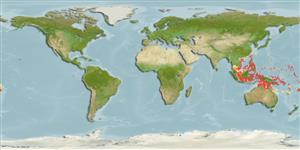>
Gobiiformes (Gobies) >
Gobiidae (Gobies) > Gobiinae
Etymology: Priolepis: Greek, prio = to saw + Greek,lepis = scale (Ref. 45335); pallidicincta: Name from Latin 'pallidus' meaning pale and 'cinctus' meaning banded - referring to the color pattern; noun in apposition.
More on authors: Winterbottom & Burridge.
Environment: milieu / Zona climática / intervalo de profundidade / distribution range
Ecologia
marinhas associadas(os) a recifes; não migratória; intervalo de profundidade 1 - 56 m (Ref. 90102). Tropical
Western Pacific: Sulawesi through Guam and the Gilbert Islands to Fiji.
Tamanho / Peso / Idade
Maturidade: Lm ? range ? - ? cm
Max length : 2.8 cm SL macho/indeterminado; (Ref. 10753)
Descrição suscinta
Chaves de identificação | Morfologia | Morfometria
Espinhos dorsais (total) : 7; Raios dorsais (total) : 10 - 11; Espinhos anais: 1; Raios anais : 8 - 9. Characterized by alternating yellowish-brown and pale grey to whitish bars on head and body; six broad yellow-brown bars on body; pelvic frenum absent; longitudinal scale series 26-28; ctenoid body scales, cycloid on base of pectoral fin and breast; 13-14 predorsal scales, ctenoid; opercle with maximum of two cycloid scales, absent on cheek; depth of body 4.2 in SL (Ref. 90102).
Body shape (shape guide): fusiform / normal; Cross section: compressed.
Cryptic inhabitant of crevices and caverns in 1-56 m (Ref. 90102).
Ciclo de vida ou comportamento de acasalamento
Maturidade | Reprodução | Desova | Ovos | Fecundidade | Larvas
Winterbottom, R. and M. Burridge, 1993. Revision of Indo-Pacific Priolepis species possessing a reduced transverse pattern of cheek papillae, and predorsal scales (Teleostei: Gobiidae). Can. J. Zool. 71:2056-2076. (Ref. 10753)
Status na Lista Vermelha da UICN (Ref. 130435: Version 2025-1)
Ameaça para os humanos
Harmless
Uso pelos humanos
Pescarias: sem interesse
Ferramentas
Relatórios especiais
Baixar XML
Fontes da internet
Estimates based on models
Preferred temperature (Ref.
123201): 26.5 - 28.9, mean 27.9 °C (based on 326 cells).
Índice de diversidade filogenética (Ref.
82804): PD
50 = 0.5000 [Uniqueness, from 0.5 = low to 2.0 = high].
Bayesian length-weight: a=0.01023 (0.00477 - 0.02194), b=3.01 (2.83 - 3.19), in cm total length, based on LWR estimates for this (Sub)family-body shape (Ref.
93245).
Nível Trófico (Ref.
69278): 3.1 ±0.3 se; based on size and trophs of closest relatives
Resiliência (Ref.
120179): Elevada, tempo mínimo de duplicação da população menor que 15 meses (Preliminary K or Fecundity.).
Fishing Vulnerability (Ref.
59153): Low vulnerability (10 of 100).
🛈
Nutrients (Ref.
124155): Calcium = 315 [140, 858] mg/100g; Iron = 1.51 [0.70, 3.09] mg/100g; Protein = 18.1 [16.0, 19.9] %; Omega3 = 0.183 [0.067, 0.448] g/100g; Selenium = 31.2 [11.6, 76.0] μg/100g; VitaminA = 130 [31, 527] μg/100g; Zinc = 3.68 [2.15, 5.86] mg/100g (wet weight);
